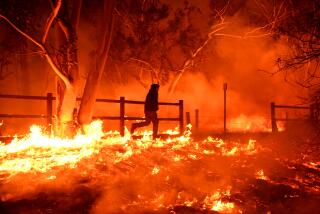Sen. Boxer suggests Edison ‘misled’ public on San Onofre plant
A letter sent by a Southern California Edison executive in 2004 shows the company was concerned about the possibility of design flaws in replacement steam generators manufactured by Mitsubishi Heavy Industries that could lead to the type of “disastrous” equipment problems that ultimately led to the San Onofre nuclear plant’s yearlong shutdown.
The letter was released by Sen. Barbara Boxer (D-Calif.), who argued that the letter shows that Edison may have misled federal regulators about the extent of design changes in the new steam generators.
Boxer called for the U.S. Justice Department to investigate whether there was wrongdoing by Edison. The U.S. Nuclear Regulatory Commission’s office of investigations is already probing whether Edison gave the agency complete and accurate information about the steam generators, and the NRC’s office of inspector general is also investigating.
The nuclear facility was shut down more than a year ago after a steam generator tube sprung a leak and released a small amount of radioactive steam.
Boxer pointed to a section in the letter that says, “although the old and new steam generators will be similar in many respects, they aren’t like-for-like replacements.”
There has been an ongoing dispute between Edison and opponents of the nuclear facility about the extent of the design changes between the new and old steam generators. Environmental group Friends of the Earth has asserted that many of the design changes should have prompted a license amendment, which would potentially involve a lengthy public hearing process, and that Edison deliberately sidestepped that process.
“This correspondence leads me to believe that Edison intentionally misled the public and regulators in order to avoid a full safety review and public hearing in connection with its redesign of the plant,” Boxer said in a statement.
”... Given this new information, it is clear to me that in order for this nuclear plant to even be considered for a restart in the future all investigations must be completed and a full license amendment and public hearing process must be required.”
Edison said in a statement that the letter showed that the company was taking care to make sure Mitsubishi addressed potential design issues. The company disputed the assertion that the design differences between the new and old steam generators -- which included adding hundreds more tubes and making changes to the support structures -- should have triggered a license amendment.
“These differences, which were intended to improve the overall performance of the new units, were determined as being insufficient to place the project outside of the parameters of the NRC’s section 50.59 regulation, which is sometimes erroneously described as a ‘like for like’ provision,” the company said in a statement.
Edison chief nuclear officer Pete Dietrich said in a statement, “SCE’s own oversight of MHI’s design review complied with industry standards and best practices. SCE would never, and did not, install steam generators that it believed would impact public safety or impair reliability.”
Edison did request and receive two license amendments relating to the steam generator replacement, but not for all of the design changes.
The plant’s four new steam generators began operating in 2010 and 2011. In January 2012, a steam generator tube began leaking and led to the discovery that the tubes were wearing down much more quickly than they should have. The plant has been shut down since the leak.
The 2004 letter, which was written to Mitsubishi by Edison Vice President Dwight E. Nunn early in the design process, expressed a concern that “design flaws could be inadvertently introduced into the steam generator design that will lead to unacceptable consequences (e.g., tube wear and eventually tube plugging). This would be a disastrous outcome for both of us and a result each of our companies desire to avoid.”
Nunn wrote: “This will be one of the largest steam generators ever built for the United States and represents a significant increase in size from those that Mitsubishi Heavy Industries has built in the past. It will require Mitsubishi Heavy Industries to evolve a new design beyond that which they currently have available.”
The letter then went on to discuss, in detail, areas of concern. One of those was the design of anti-vibration bars intended to prevent tubes from shaking excessively. The design of the bars ultimately led, in part, to the plant’s issues, as it did not prevent the tubes from vibrating and knocking against adjacent tubes and support structures.
“Since the San Onofre steam generators are one of the largest steam generators ever built and large steam generators appear more susceptible to wear (in fact, our current steam generators have experienced a high percentage of plugged tubes due to wear), it is a paramount concern of ours that we ensure a reliable support design,” Nunn wrote. He said Mitsubishi and Edison “are having difficulty in formulating” a plan that would address the potential issue.
The NRC is currently weighing a proposal by Edison to restart one of the plant’s two units at 70% power. Boxer and others have pushed the agency to hold trial-like public hearings before making a decision on the proposal. Edison and Mitsubishi have not yet settled on a long-term repair plan, and Edison has signaled that it may shut the plant down for good if the NRC does not give the go-ahead for the partial restart.
NRC spokesman Eliot Brenner declined to comment on the letter.
ALSO:
Five Irvine teens killed in fiery Newport Beach car crash
Mother, boyfriend due in court in 8-year-old’s torture death
Justin Bieber accused of driving freeway speeds in neighborhood
More to Read
Start your day right
Sign up for Essential California for news, features and recommendations from the L.A. Times and beyond in your inbox six days a week.
You may occasionally receive promotional content from the Los Angeles Times.







